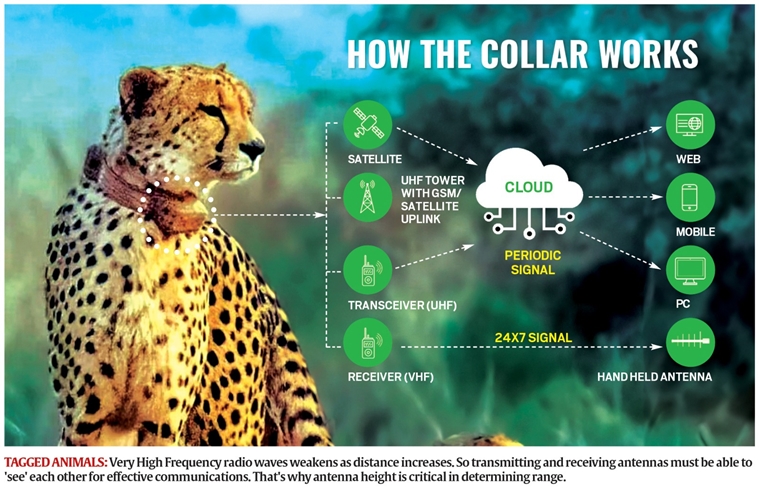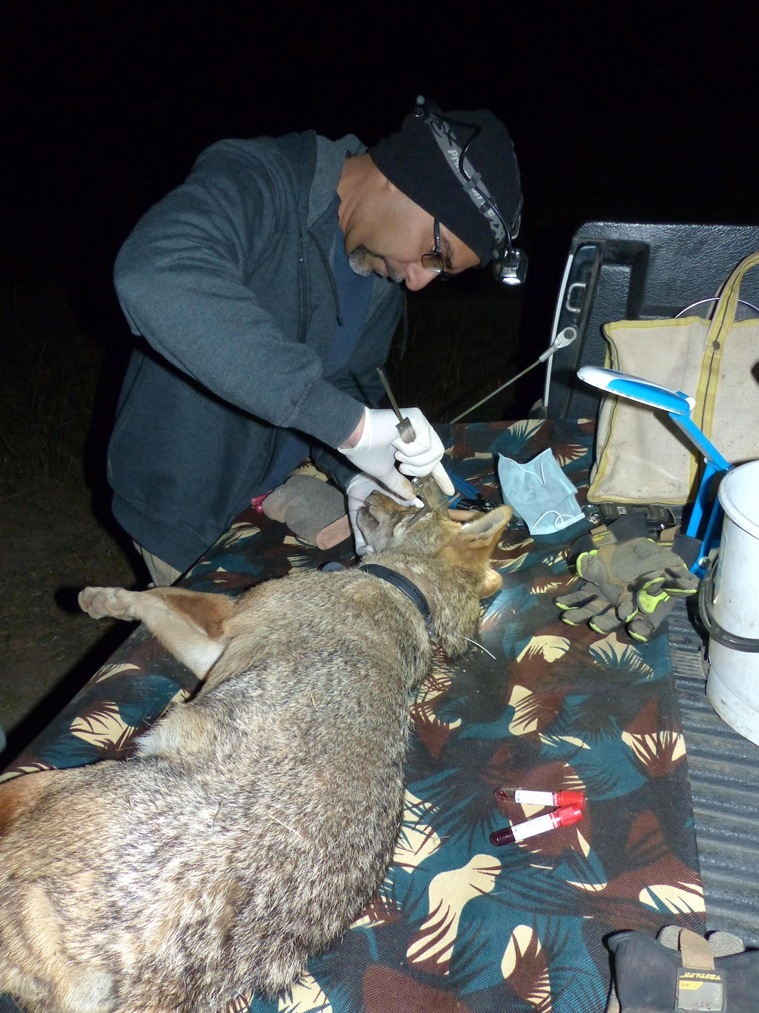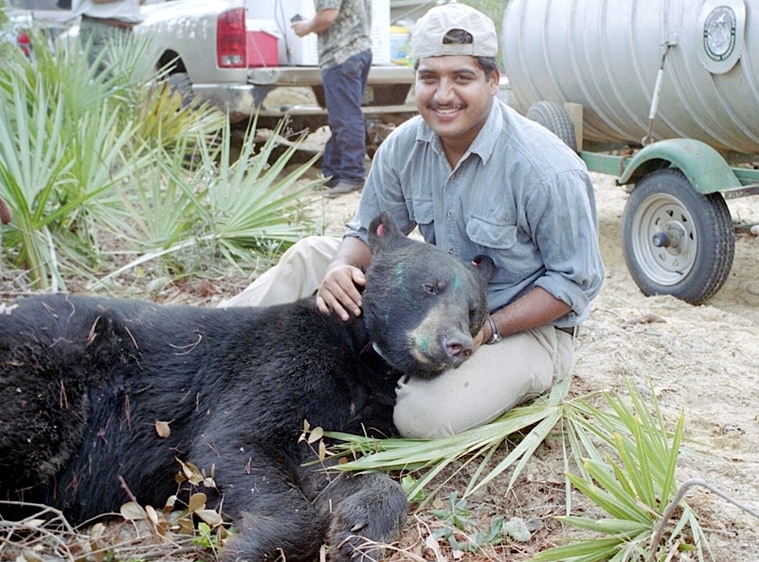
Except for one cheetah that has gone missing, all the surviving ones are now being looked after inside enclosures. Barring further setbacks, they are likely to be released again in the wild, with collars fitted, once the rains stop and the temperature drops in Kuno. While there is no final word yet on how to avoid a similar crisis the next monsoon, the project team hopes that the cats and their body clock will soon adjust to the new conditions and geography.
The Indian Express spoke to four leading field biologists on their experience with radio-collaring different species and what might have gone wrong with the collars in Kuno. Excerpts:

RAGHUNANDAN SINGH CHUNDAWAT: Known for his pioneering decade-long field study of tigers in the Panna tiger reserve of Madhya Pradesh, Dr Chundawat put VHF collars on a snow leopard, several tigers and deer.
My experience with radio-collaring: When I radio-collared a snow leopard for my PhD research, I felt that the collar, made of double Butyl (polymer) layers, was too big and too stiff for the animal.
When I came to procure radio collars for tigers in the late nineties, I was suggested Telonics MOD 600, which was used for lions, and had two layers of Butyl with the antenna sandwiched between.
Story continues below this ad
Instead, I preferred the MOD400, which was designed for wolves and asked for an outer layer of canvas. This made the collar lighter and also more flexible so it could fit snugly and was almost unnoticeable under the tiger’s chin. These collars fitted well on the round neck of carnivores and we did not observe any behavioural response to these external bodies on them.
 Dr Raghunandan Singh Chundawat radio-collaring a tigre in Panna tiger reserve in Madhya Pradesh
Dr Raghunandan Singh Chundawat radio-collaring a tigre in Panna tiger reserve in Madhya Pradesh
The canvas layer had two advantages. It made the collar flexible. Secondly, in case the transmitter failed, the canvas would deteriorate and the collar would break off on its own. The limitation was that since I wanted to monitor animals for a long period, I had to replace the collar within 30 months.
Risks involved: I never faced any problems due to collars. Except once, when the canvas layer deteriorated fast and the antenna came out sideways. It soon broke and began to rub against the neck. We immediately tranquilised the tiger and removed the collar before it could cause serious injury.
What may have gone wrong in Kuno: The deaths of several cheetahs due to similar injuries and infection close to the collar are worrying. That such injuries went unnoticed for so long that serious infection set in and caused death indicates poor field monitoring by inexperienced persons. Any irritation and injury on the neck will cause the animal to constantly shake its head to keep the flies away. This will reflect in an overwhelmingly active signal every hour. An experienced monitoring staff would notice this unusual active signal and investigate. Once an animal is in sight, it would be simple to figure out the source of restlessness.
Story continues below this ad
When not fitted properly — too loose, for example — a collar’s regular movement can cause rubbing and injury. The neck is not of a continuous width — it is wider close to the body and narrower close to the head. Injury can happen when the collar is not placed snugly close to the chin but elsewhere on the neck as it can move between where it was placed and the chin, which can lead to problems. Placing a collar in summer or winter also makes a difference and the tightness of the collar must be adjusted accordingly.
ABI TAMIM VANAK: Dr Abi Vanak has conducted the first-ever GPS collaring of lesser-known carnivores such as the Indian fox, jungle cat, golden jackal and striped hyena.
My experience with radio-collaring: In all GPS tags, it is a trade-off between the quantity of information and the longevity of the battery. The rule of thumb is that the collar should weigh under 3% of the body weight. However, this depends on the activity and locomotion of the species. Some species (such as cheetahs) require lighter collars because of their speed and the sudden sharp turns they can take while chasing prey. This can result in extra stress on the skin around the neck.
Risks involved: There are always risks. Sometimes the animal can lose body condition and the collar can become loose and can cause abrasion. Or the animal could increase in body weight or put on a thicker coat during winter, causing the collar to become too tight. It requires an experienced hand to properly fit collars or other types of tags.
 Dr Abi T Vanak fits a GPS collar on a golden jackal in the grasslands around Baramati in Maharashtra
Dr Abi T Vanak fits a GPS collar on a golden jackal in the grasslands around Baramati in Maharashtra
What may have gone wrong in Kuno: The cheetahs need to be fitted with lighter collars with a softer belt material. Also, there needs to be better monitoring of the animals with on-field observations.
Story continues below this ad
ARJUN GOPALASWAMY: Has been associated with collaring projects on black bears in Florida, tigers in Thailand and lions in Africa.
My experience with radio-collaring: The process of fitting a radio collar on a wild animal occurs in a brief window (around 45 minutes) when the animal is chemically immobilised. Along with this, other research tasks such as taking blood samples and body measurements must be completed before recovery. Therefore, thorough research beforehand is essential.
The choice of collar largely depends on the research question. Today’s collars may include accelerometers, sound recorders, or temperature recorders. But a feature shouldn’t be added if unnecessary.
A collar’s weight is determined mostly by the size and weight of the transmitter. A lighter collar usually has a shorter battery life/limited range, leading to more replacements. Generally, these days, collars are fitted with VHF and GPS, often with a remote or timed drop-off mechanism.
Story continues below this ad
Risks involved: Collars causing adverse impacts is uncommon. Best practices in collar use have been shaped by studies on various species and locations over decades.
 Dr Arjun Gopalaswamy with a black bear collared in Florida
Dr Arjun Gopalaswamy with a black bear collared in Florida
However, I’ve seen occasions where collars are fitted too tightly or loosely. When young animals are collared for dispersal studies, they may outgrow the collar. During chemical immobilisation, it’s vital to accurately age the animal in the field using body measurements, weight and teeth stains.
For young animals, expandable, breakaway collars should be considered. Injuries from collars are rare but can exacerbate other injuries (from snares, for example). Therefore, a widely followed ethical rule is: if collaring an animal, ensure you or your team remains with it in the field.
What may have gone wrong in Kuno: A doctor aims to solve problems quickly to save lives while a scientist seeks to discover the underlying cause. This perspective is vital to resolving Project Cheetah’s current issue.
Story continues below this ad
According to what has appeared in the news, the eight cheetahs in Kuno have suffered skin infections, with three fatalities. With the rest having been treated with antibiotics, the doctor’s problem is resolved, but the scientist’s query persists.
The current hypothesis likens the issue to a chain reaction: heavy rain, high temperature, collar fitment, and winter coat development kept moisture under the collar, leading to skin infection, attracting flies, causing maggots, spreading bacteria, and proving fatal.
I can’t dismiss this hypothesis outright, but the same collars (AWT, 400 gm) have been used in Maasai Mara, Kenya, without issue, despite higher rainfall. This situation demands a thorough, science-based approach to propose and test other hypotheses, a challenging task.
BILAL HABIB: Dr Habib has handled collaring projects of a wide range of species such as marmot, red fox, wolf, wild dog, tiger, leopard, gaur, GIB and black-necked crane.
Story continues below this ad
My experience with radio-collaring: The most important aspect is that collar design (payloads) should align with research objectives, whether tracking movements, studying behaviour, monitoring health, or monitoring reintroduced species. Don’t make your collars heavy by adding unnecessary sensors and attachments.
The collar material should be lightweight and durable to minimise discomfort and potential injury. Collars should be appropriately sized to prevent chafing or constricting the animal’s movements. A snug fit without excessive tightness is crucial. One has to be very careful while deciding the circumference of the collar and the shape. For carnivores, we use round collars while for ungulates we use oval collars.
A balance between data collection and animal comfort is key. Collar weight should not impede the animal’s mobility or balance. We have to think about secure and humane attachment methods. I prefer to use drop-off collars so that if any issue is noticed, the collars can be immediately removed, without the requirement for the animal to be captured.
Risks involved: I have been associated with collaring species weighing from 3 kg to 900 kg, using collars/tags weighing from 30 gm to 2 kg. Of course, there will be some minor adverse impacts of collars on animals, but those can be avoided by careful planning and meticulous monitoring. The information generated for the scientific management of a species as a whole outweighs the negative impacts.
Story continues below this ad
What may have gone wrong in Kuno: I don’t think monsoon is the issue. Monsoon only aggravates the problem if there is any infection. The neck of a cheetah is different from other predators. It is more elongated and flexible. This unique anatomy allows cheetahs to rotate their necks quickly and track their prey while running at high speeds. It also aids in maintaining balance and stability during high-speed chases.
Once the cheetah catches up to the prey, it uses its sharp (not strong) teeth to deliver a bite to the throat or clamps its jaws around the windpipe to suffocate the prey. This ensures a swift kill, minimising the risk of injury. For antelopes in Africa, the chase by a cheetah is well adapted for easy suffocation and subsequent death, whereas the common prey in Kuno — the chital — may require more power and neck movement. This makes cheetahs in India more susceptible to collar injuries.
The cheetah’s high-speed movements can make the collar scratch the neck, resulting in minor bruises. The monsoon may have allowed these bruises to turn fatal – if that is the cause of the death. So the width of the collars can be much smaller for cheetahs to avoid injury while chasing and tearing the food. The payloads on the collar can also be minimised for the initial period.
Also, I think the absence of regular GPS locations because of low GSM coverage may have put too much pressure on the monitoring teams to locate the cheetahs on the ground. This may have put more stress on the cheetah to move further, and more pressure on those minor bruises. Continued friction and pressures on the wounds may have prolonged the healing process.
The Kuno hypothesis
While radio collar wounds are not unheard of among big cats in India — wildlife biologist Dr Y V Jhala, the architect of the Cheetah project, earlier told The Indian Express of two occasions when collars were taken off a tiger and a lion to treat maggot-infested wounds — they are considered rare. Experts associated with the project blamed three factors for what went wrong with the cheetahs in Kuno:
>> Untimely winter fur: The cheetahs were brought from the southern hemisphere where the winter solstice is in June. So the animals grew a thick winter coat as the monsoon peaked in India. This extra fur held more water and did not let the skin dry for extended periods. This ‘wet mat’ effect could weaken the skin over time.
>> Speed and momentum: The general rule for radio collars is to stay below 3% of an animal’s body weight. A 2020 study led by researchers from Swansea University, UK, criticised this calculation for not factoring in “animal athleticism”.
Using collar-attached accelerometers, the researchers found that during movement, the forces exerted by collars were equivalent to up to five times the collar’s weight for a lion and a massive 18 times for a cheetah. In theory, that would make a standard 400 g collar ‘weigh’ more than 7 kg on a sprinting cheetah — a lot of weight to carry on a wet coat.
>> Low immunity, novel pathogens: The pathogens that aggravated the wound under the collar could be novel either to the African cheetahs or to Indian conditions. These animals could be vulnerable to certain local pathogens. Or they could have carried some dormant pathogens that flourished in Kuno given the animals’ loss of immunity due to stress.




 Dr Raghunandan Singh Chundawat radio-collaring a tigre in Panna tiger reserve in Madhya Pradesh
Dr Raghunandan Singh Chundawat radio-collaring a tigre in Panna tiger reserve in Madhya Pradesh Dr Abi T Vanak fits a GPS collar on a golden jackal in the grasslands around Baramati in Maharashtra
Dr Abi T Vanak fits a GPS collar on a golden jackal in the grasslands around Baramati in Maharashtra Dr Arjun Gopalaswamy with a black bear collared in Florida
Dr Arjun Gopalaswamy with a black bear collared in Florida




































